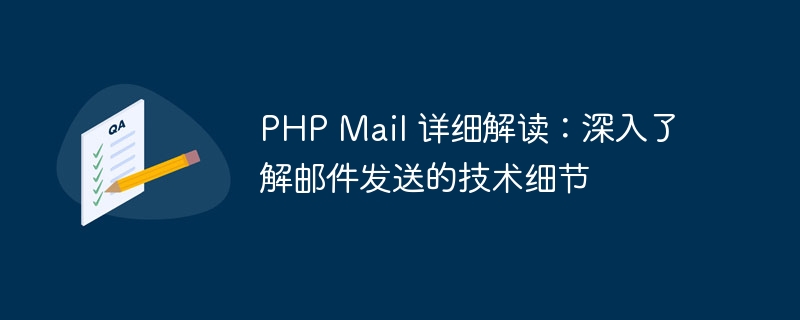

PHP is a popular server-side scripting language widely used for web development. Sending emails is one of the common functions in web applications. How to use PHP to send emails is a skill that developers need to master. This article will provide an in-depth explanation of the email sending function in PHP, discuss its technical details, and provide specific code examples.
In PHP, you can use the built-in mail() function to send emails. The mail() function accepts multiple parameters, including recipient email address, subject, email content, etc. When the mail() function is called, PHP will pass the email information to the server's mail transfer agent (MTA), and then the MTA is responsible for sending the email to the recipient's mailbox server.
Before using the mail() function to send mail, you need to ensure that the mail service has been correctly configured on the server. Generally speaking, you can set the mail server information by configuring the SMTP server address and sender email address in the php.ini file. The following is a simple example:
ini_set("SMTP", "mail.example.com");
ini_set("sendmail_from", "info@example.com");The following is a sample code that uses the mail() function to send a simple text email:
$to = "recipient@example.com"; $subject = "测试邮件"; $message = "这是一封测试邮件。"; $headers = "From: sender@example.com "; mail($to, $subject, $message, $headers);
If you need to send emails with attachments, you can use the PEAR library or other third-party libraries to achieve this. The following is an example of using the PEAR library to send emails with attachments:
require_once "Mail.php";
require_once "Mail/mime.php";
$to = "recipient@example.com";
$subject = "测试邮件";
$message = "这是一封带有附件的测试邮件。";
$from = "sender@example.com";
$host = "smtp.example.com";
$username = "username";
$password = "password";
$headers = array(
'From' => $from,
'To' => $to,
'Subject' => $subject
);
$mime = new Mail_mime("
");
$mime->setTXTBody($message);
$file = "/path/to/attachment.pdf";
$mime->addAttachment($file, 'application/pdf');
$body = $mime->get();
$headers = $mime->headers($headers);
$mail = Mail::factory('smtp', array(
'host' => $host,
'auth' => true,
'username' => $username,
'password' => $password
));
$mail->send($to, $headers, $body);During the email sending process, various errors may occur. You can judge whether the email is sent successfully by the return value of the mail() function, such as:
if(mail($to, $subject, $message, $headers)) {
echo "邮件发送成功!";
} else {
echo "邮件发送失败,请检查配置信息!";
}When using PHP to send emails, you need to pay attention to some security issues to prevent Being abused for spamming. It is recommended to take the following measures:
Through the detailed interpretation of this article, readers can have an in-depth understanding of the technical details of email sending in PHP, and master how to use code to implement the email sending function. In actual development, based on specific business scenarios, email sending technology is flexibly used to provide users with a better service experience. I hope this article is helpful to readers, thank you for reading!
The above is the detailed content of Detailed interpretation of PHP Mail: In-depth understanding of the technical details of email sending. For more information, please follow other related articles on the PHP Chinese website!